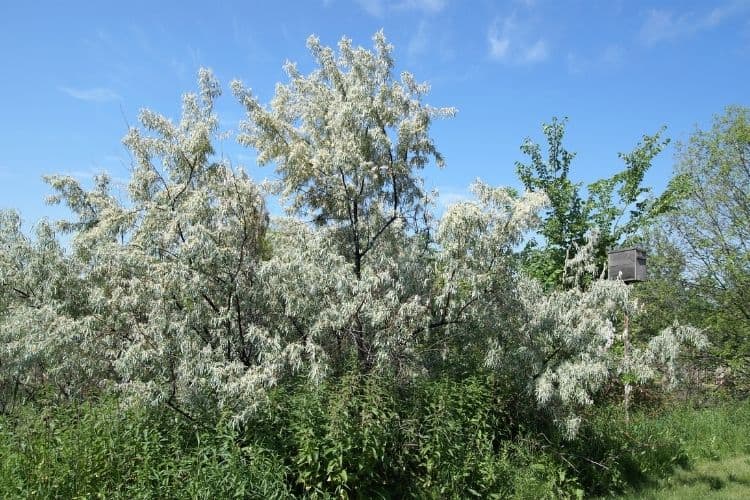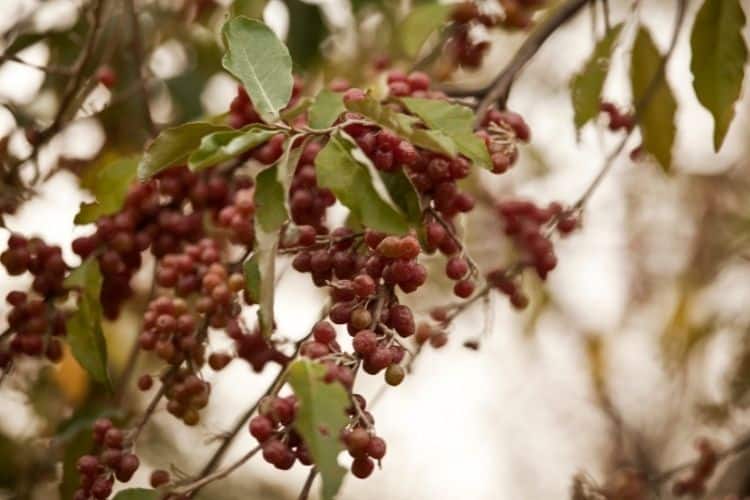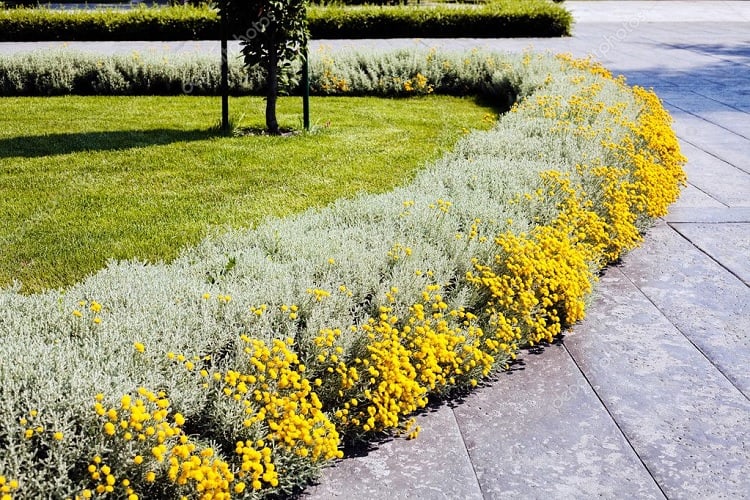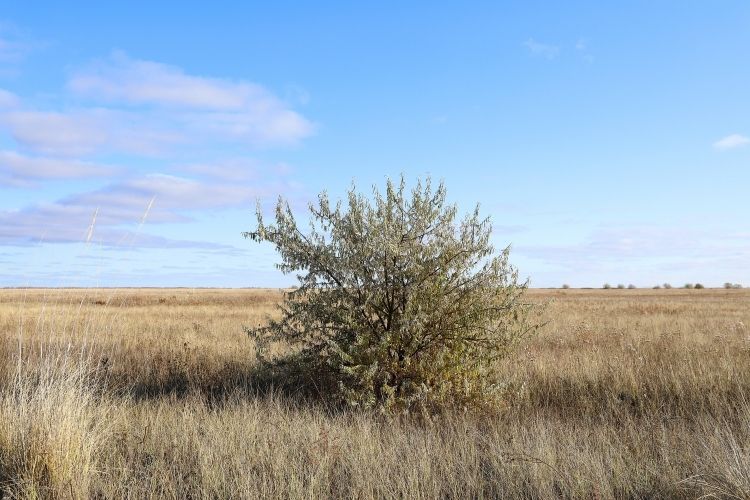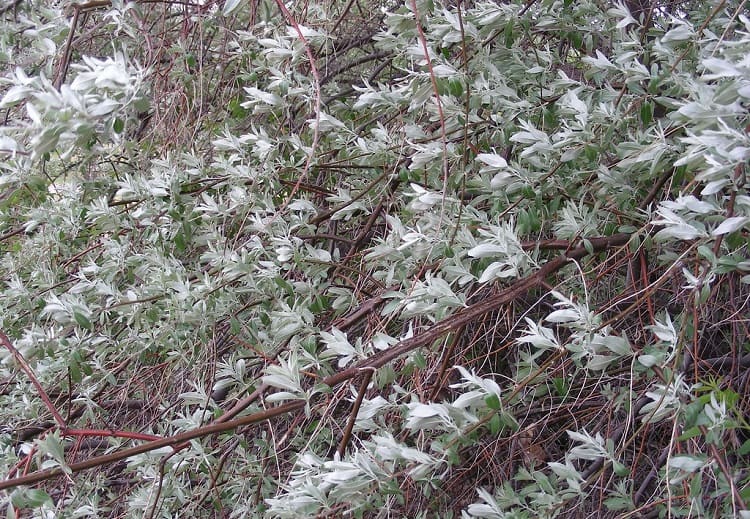- Apricot Tree: Can You Really Grow It On Your Own? - November 29, 2021
- Lavender Tree: How Soon Your Can Expect Your Tree To Grow? - November 2, 2021
- Bottle Brush Tree: Can You Grow It In Your Own Yard? - November 2, 2021
Silvery leaf color, thorny, large shrub but a small tree that can tolerate alkaline or saline soils – these are some of the attributes of the Russian olive tree (Elaeagnus Angustifolia).
For all folks out there looking for an invasive tree that can compete with native plants, particularly in saline lowlands, riparian zones, or wetlands, we present a plant native to western Asia and southern Europe – the Russian olive tree.
Before we move on, we encourage you to do your due diligence because growing the Russian olive tree is sometimes illegal according to country or state regulations.
To a large extent, growers can see the Russian olive tree in most continental United States. However, the plant is more prevalent in western states. The Russian olive tree has infested riparian settings, spreading from original plantings.
While many western states advocated aggressive strategies to eliminate or minimize infestation, they have even listed the plant as a noxious weed. As a plant that grows best in dry climates and soils, the Russian olive tree is drought resistant with brown bark on older trees with furrows and ridges. It is a multi-trunk tree with fragrant yellow flowers and silvery foliage.
You can use this plant for field windbreaks or farmsteads. However, we must warn you with the Russian olive tree seeds because you must spread the seeds prolifically and overrun unmanaged sites, particularly saline areas.
How to Identify Russian Olive Tree
The Russian olive tree foliage is deciduous, linear, simple, alternate to semi-evergreen with a whole margin of about one to three inches long and a width of about 0.75 inches. The plant is dull green above and silvery below. This Elaeagnaceae family plant resembles the buffalo-berry and silverberry, the common native species of western North America.
The plant is a small tree with large shrubs that grow to about eight meters tall, with thorny stems and silvery-mealy texture. Leaves are alternately assembled, with narrowly lanceolate blades with smooth margins and silvery, white-mealy beneath. They are about 3 to 10 cm long with short petioles.
The four-sepal flowers are yellow on the inside and silvery outside with no petals. A tube formed by the stamens and sepals (about 2 to 4 mm long) surrounds the superior ovary without any attachment. This silvery tube is about 5 to 6 mm long.
This plant can be classified as a multi-stemmed shrub or small tree. Its spring growth starts in late April after losing its leaves during winter. The plant’s branches may possess sharp thorns, and barks are reddish-brown. It blooms in May through June, and they are highly fragrant, arranged in clusters, and yellow.
Its fruit has a fleshy outer layer covering a large football-shaped seed. They are about 0.3 to 0.5 inches long and are oval-shaped. The plant has large seeds compared to willows and cottonwoods.
Experts have connected its large seed with enhanced survival in shade, growth, and improved seedling establishment. With these characteristics, the Russian olive tree increases the plant’s competitiveness and establishes intact vegetation.
Where Does Russian Olive Tree Grow
The Russian olive tree is beautiful with its silver-gold colors and is hardier than classical olive trees. The plant spreads to several parts of Europe, and many people use it as a valuable and ornamental shrub, grown along the stream courses, riverbanks, or floodplains.
Growers also plant the Russian olive tree along irrigation ditches and marshes to an elevation of about 6000 feet. The plant can withstand a significant amount of drought and considerable alkalinity or salinity. Russian olive tree can withstand periods of hot and warm temperatures as it is hardy down to -40 degrees Fahrenheit. The plant does not have any competition, and it is a highly vigorous tree.
Any well-drained soil is perfect for this plant. Germinating from the root crown and sending up root suckers, this perennial can even tolerate silting and flooding and thrives well under a wide range of soil textures, from heavy clay to sand.
A site or garden with the full sun will help the Russian olive tree resist pests or diseases. The USDA zones two through seven are perfect for the plant and can withstand winter conditions.
Russian olive tree is a drought-resistant and hard plant that will bounce back faster when a specifically severe dry or frost spell kills native plants. The plant can also fix any nitrogen reserves in the wood and roots as it alters them. With this, other plants will not have enough amounts of nutrients since they cannot compete with the plant.
Even elm, poplar, black cottonwood, or native willows cannot compete with the Russian olive tree that has been shown to crowd and outgrow them. Essentially, it will not allow other seeds to germinate, growing lush and dense.
Uses of Russian Olive Tree
One of the best uses of the Russian olive tree is for its color accent. Many people use the plant for impenetrable screens or borders, even though some claim it is excellent for small woodwork pieces. In Europe, they use the plant as a useful or ornamental shrub. Planters also use the tree to stave off erosion, being a resilient plant. Earlier horticulturists also stored and sold the Russian olive tree to their clients.
In essence, the plant serves as wind-resistant decorative hedges. It also provides melliferous flowers for beers, alleviates riverbanks, and marks property edges.
Additionally, many people use the Russian olive tree as a diuretic, antipyretic, and analgesic medicine. Experts have derived various compounds from the Russian olive tree and made the plant a source of vitamins, minerals, alkaloids, and flavonoids.
How to Grow Russian Olive Tree from Seed
The process of growing your Russian olive tree from seed is not that hard. The process starts with soaking the seeds in hot tap water and leaving them for six hours in the water. The stratification stage of this process can take up to 90 days, and after that, you can start thinking of sowing the seed about ¾ inch deep into moist soil.
Fall is the perfect time to obtain your Russian olive tree fruits. By then, they are completely ripe. Except birds eat them or you pick them, these fruits will be on the branches.
Therefore, ensure to choose only the blemish-free and smooth fruits. In addition, let the fruit dry out by putting it in a dry, warm place. When you notice that the fruit coating is leathery, dry, and you can use a thumbnail to piece them, it is a sign that the seeds are ready to store.
Have a clear plastic zip-bag handy and fill it with sand halfway. Next, mix some water into the soil until it becomes damp. Then, use an emery board to scrape each seed’s body to eliminate the outer shell. After that, place the seeds in the wet soil.
We recommend putting this bag where no one can access it, especially in a refrigerator drawer. This stratification is critical for the Russian olive tree seeds to germinate when at a temperature above freezing. Leave it for about 90 days in the refrigerator and check it now and then to ensure your soil stays damp.
The next stage is to add peat moss or sand in a seedling or planter with sufficient water to dampen the growing medium. Wait till the spring to plant your stratified seeds in the seedling tray or planter.
With that, the danger of frost would have passed. Pat your medium over the seeds after placing them as deep as their length. With that, they can have sufficient contact with the surface.
Ensure that the medium is not wet but moist and avoid having direct sunlight on the planter. Most of these seeds will germinate in one or two months. Then, you can transplant seedlings after seeing about two sets of leaves to their more permanent site.
Russian Olive Tree Growing Conditions
Russian olive tree is incredibly tolerant of environmental factors, and if you live in a high wind area, you will find this deciduous as the best windbreaker plant. Many growers typically plant Russian olive trees for easy cultivation, olive-like fruit, small fragrant flowers, and silvery foliage.
Generally, people grow it along riparian corridors, rights-of-way, highways, roads because of its salt tolerance. This plant survives in adverse environmental conditions due to its nitrogen-fixing nodules.
Planters grow it ten inches apart so it can grow into a fast-growing hedge. Therefore, the Russian olive tree can display a high tolerance for alkali and salt and has low water requirements. The plant is an evergreen plant and a favored shrub grown for deer, wild turkey, and other wildlife food sources.
Russian olive tree is an aggressive, fast-growing species that can be hard to eradicate when established. In addition, roots can increase the soil nitrogen composition as it fixes nitrogen, altering the plant composition community growing on the site. Leaf litter can even affect nutrients in streams.
When you notice that the soil is moist and the plant is young, ensure to pull it. You will also find success when you combine chemical and mechanical methods. For example, apply herbicides to the stump instantly after cutting.
Russian olive tree usually starts flowering and producing fruits at three years of age. Flowers are yellowish inside and fragrant, silvery-white outside, blooming from May through June. Then, it produces a significant crop of silver-scaled, berry-like fruit resembling olives from August to October. The plant’s fruit is typically spread by wildlife, especially birds, and is edible.
The plant is found in forest edges, open forests, and forest openings as scattered plants. While the Russian olive tree is shade tolerant, it resprouts and proliferates after burning or cutting.
When to Plant Russian Olive Tree
Full sun and sheltered, warm conditions work well for Russian olive trees. If you have the perfect conditions, you can plant it throughout the summer. However, the most common times to plant Russian olive trees are fall and spring.
The plant will have all summer to bloom and grow into its environment before the winter cold sets in, which is the essential advantage to spring planting.
When you have about ten degrees centigrade, Russian olive trees typically produce flowers for at least two months. However, the fluctuations between the day and night temperatures mean the plant requires a 12 to 15 weeks period.
As such, you can grow your Russian olive tree in open farms and gardens in many parts of New Zealand, South African, and Australia. There is a need for a warm to hot summer before the Russian olive tree can set fruit. Get your Russian olive tree from your garden or nursery stores and request fruit harvest plants and not oil production.
It is also crucial to know that the larger the specimen, the sooner your plant will produce fruit. Therefore, your tree may not start fruiting until it is about five years old.
Autumnal plantings in warmer winter climates have the advantage of being in the ground before the rain comes and settle the plant for the winter. Therefore, your plant will be ready for growth when the soil and air are warm in the spring as they can rest for the winter.
Essentially, it would help if you timed the summer plantings correctly. Avoid planting without the assurance of having a working irrigation system or before a heatwave.
Generally, we recommend not to grow in winter since the soil will be too wet. When you work on damp soil, you will have slippery mud and thus, eliminate all the oxygen pockets, leaving an oxygen-less, heavy vault for the roots.
How to Plant Russian Olive Tree
Russian olive tree is an invasive, non-native species that can take up to 75 gallons of water per day, pushing out native trees, including cottonwoods and willows.
Planting this shrub involves digging a hole twice the root ball size and deep enough with the same level your shrub was in the pot. You can use a mixture of half soil amendment or compost or half original soil to fill a wider hole if you have poor soil.
When removing your shrub from the container, do that with extra care and separate the roots gently. Let the best side face forward as you put it in the center of the hole.
Use your amended mixture or the original soil to fill in if required. You can also have a water well if your shrub is larger. Finish the process by watering and mulching well. If your plant is balled-and-burlapped, we recommend folding the natural burlap top back after removing the fasteners and tying it into the hole. Ensure to have positioned your shrub before doing this.
Also, remember to bury all burlap to prevent wicking away water from rootballs during dry, hot periods. We also recommend removing it if you have synthetic burlap. If not possible, you can make slits or cut away to allow roots’ development into the new soil. Create a water well for larger shrubs and ensure to mulch and water adequately.
Additionally, check to see the discoloration somewhere close to the base by the soil line when you have a bare-root shrub. Apply organic matter if you have highly clayey or sandy soil. With that, you can improve the water holding capacity and drainage. Firmly fill the soil to support the shrub, and remember to mulch and water well.
If you intend to plant your Russian olive tree to make a hedge, you have two options: having a more formal shape with prudent pruning or training the borders to be informal with only sporadic shaping. The first two seasons are critical as you must ensure to shear off about two to six inches from the top several times. With that, you will encourage branching.
Never attempt to cut the sides at a 90-degree angle, which is the typical mistake most growers make. You will have a leggy open canopy with the top growth shading the bottom. However, your tree will flare out at the bottom when you cut the sides at an angle. You can ensure compact and healthy growth down to the bottom of your shrub.
Russian Olive Tree Water Requirements
Intermittent, deep watering is essential for Russian olive trees to encourage healthy growth. As a rule of thumb, water your Russian olive tree every third day of the first two weeks when newly planted. After the first fourteen days, you can reduce the amount of water to once a week.
The normal watering if you plant outdoors involves keeping the soil moist through regular watering. Do this as required by the conditions. We have discovered that most plants tend to grow well with at least one inch of water in their growing season. However, ensure not to overwater.
For example, the Russian olive tree needs constant watering for establishment during the first two years of planting it, the more critical being the first year; watering deeply and once a week is better than frequent watering for a few minutes.
Regarding constant moisture for outdoor plants, ensure to water the plant if it doesn’t get the preferred one inch of moisture most plants favor. The growing season requires average watering.
However, be careful not to overwater. Therefore, constant watering is essential for the first two years of planting your Russian olive tree. Since the first year is crucial, ensure to water deeply once a week instead of constantly for some minutes.
Russian Olive Tree Sun Requirements
Generally, the Russian olive tree needs as much sunlight as possible to grow well at least seven hours a day. The plant belongs to a dry, hot climate and will remain in its best condition when it remains longer in more light. Russian olive tree will assume its full potential when in full sunlight. Though the plant can thrive well in less sunlight, its foliage may not be as vibrant as possible, and it may not flower as heavily.
The sunniest part of the buildings or houses are the western or southern sides, except houses are so close together that they cast shadows from nearby properties. With full sun, the plant can receive about six hours of sun.
Best Russian Olive Tree Fertilizer
Russian olive tree can withstand any soil pH. However, growers use lime to correct the pH when soils are overly acidic, with soil texture determining the amount since it varies. Before we move on, some of the things you must know about fertilizing your Russian olive tree include:
- Fertilize with a small amount several times a month and water adequately after applying the fertilizer
- Avoid the fertilizer touching the tree trunk since the high levels of nitrogen can cause burns
- Avoid fertilizing before March or after August
Now that you know this, let’s discuss how to fertilize your tree. Your young Russian olive tree will need fertilizing after planting. This case depends on the time of the year. Established Russian olive trees also need fertilizer to produce every year and stay healthy. A 16-16-16 nitrogen, potassium, phosphorus ratio is essential for a balanced fertilizer.
Various fertilizers can boost your Russian olive tree growth and even make them pest-free. Your plant will enjoy the fruiting and flowering process with a good fertilizer. In addition, it will also improve other plants’ health on your patio or inside the house.
Ensure to look for a balanced NPK fertilizer, nitrogen-source fertilizer, or nitrogen-rich fertilizer for your Russian olive tree. Your plant needs a fertilizer containing a high source of nutrients, especially nitrogen. Ensure to read the information about the nutrient ratio of the NPK fertilizer on its label and use it to determine the percentage.
Use 20-10-10 formulas of a balanced fertilizer for your established Russian olive tree. We recommend using neem oil if your plant has pest problems. The organic oil will protect your Russian olive tree from diseases and pests. Remember to carry out a leaf analysis or soil test before choosing a fertilizer. With that, you will know what your plant needs.
Best Russian Olive Tree Companion Plantings
Bunch Grasses
Bunch grasses or tussock grasses boast a decorative purpose for your landscape and thrive in tufts or clumps. As such, bunch grasses can be one of the best companion plantings for your Russian olive tree when grown in a large pot or outdoors.
Germander
Germander is exposure tolerant and can withstand drought as a Mediterranean plant—the plant pairs well with the Russian olive tree as an evergreen subshrub that blooms lavender-like flowers. People use germander to treat diarrhea, stomachache, and fever, apart from providing an attractive appearance.
Santolina
Santolina is one of the perfect companion plantings for the Russian olive tree. The plant prefers full sun and is suitable for dry, hot summer as one of the Mediterranean evergreen subshrubs. It is easy to grow and perfect for many soils.
Santolina is also an excellent addition to any landscape. The plant also fits and looks similar to silver-green Russian olive tree leave colors.
Succulents
Succulents can be one of the most favorite options as companion plants for your Russian olive tree and are remarkably adaptable. It is even easy to mix and match different varieties since they are tiny plants.
Russian Olive Tree Diseases and Common Problems
Scale Insects
Mealybugs and scales are similar and can be significant issues whether you plant your Russian olive tree indoors or outdoors. These insects will find a perfect feeding site by crawling around the plant. The adult scale females have hard shell layers to protect themselves by losing their legs and remaining on the spot.
These insects will weaken the plant, resulting in leaf drops and yellow foliage. The sweet substance they produce can also attract ants and result in sooty mold, an unattractive black surface.
Leaf Spots
Bacteria or fungi cause leaf spots. With that, black or brown patches and spots can be circular or ragged, with a yellow-edged or water-soaked appearance. Dirty garden tools, rain, insects, or even people can aid the spreading.
Rusts
Rusts live in flower debris and are overwinter and host-specific on stems and leaves. These insects are like tiny, brown, yellow, or orange pustules beneath the leaves. Rust will leave a colored spot of spores on your fingers when you touch it. Splashing water and fungi cause their spread, and rusts can be severe with moist weather.
Aphids
Aphids have various colors, ranging from black to brown and green. These pests suck fluids from the plant as slow-moving, soft-bodied, and small insects.
Some of them have wings and attack various plant species and causing deformed, stunting buds and leaves. In addition, aphids have sucking or piercing mouthparts that they use to transmit harmful plant viruses.
Verticillium or Fusarium Wilt
Soil, plant debris, or infected seed can transmit wilts, multiplying during the wet, cool season. These fungi will become apparent when you have dry or warm weather. The fungus will destroy the plant’s water-conducting systems and cause the plant to wilt. Growers can worsen the condition with overfertilization.
Russian Olive Tree Treatments and Maintenance
One of the best cares you can give your Russian olive tree is proper irrigation using a modest amount of slow-releasing fertilizer. Prune the plant to provide its soil with suitable fertilizers, and it is an essential part of the plant. As a result, your Russian olive tree can grow faster and stay upright through pruning or trimming.
It is critical to know the minimum height and width of this plant for better treatment. It is also crucial to know where and when to prune. Generally, you can prune your Russian olive tree throughout the year. However, the pruning of flowering olive trees is not the same as fruiting plants.
The main points of treating and maintaining your Russian olive tree include avoiding replanting the plant in the same place and digging out and eliminating any severely affected trees.
Additionally, prune off any diseased or dead branches, and remember to disinfect your pruning tools between each cut with rubbing alcohol. Ultimately, use balanced fertilizer to keep your plant healthy and plant your Russian olive tree in well-drained, light soil.
How to Remove Russian Olive Tree
You will need to kill the Russian olive tree root system to remove the plant entirely. There are some procedures you can use to do this. One of them is girdling, where you remove a strip of bark surrounding the whole circumference of the trunk. With that, it ends the food flow from the leaves to the roots, starving the shrub.
Girdling can also stimulate sucker growth. However, you must know that it can be time-consuming to gird each trunk of this multi-stemmed plant. Thorns can also make it hard to get to the trunk with cutting, and you can consider girdling if you have very few trees to remove.
You can also combine the use of herbicide application and herbicide treatment to remove a Russian olive tree. You will cut down the trees and spray or paint the stump immediately with an herbicide labeled for the stump treatment. With this method, you can easily remove even larger trees and remove the roots and stump later.
Cutting and mowing are other methods you can use to remove your Russian olive tree.
Where to Buy Russian Olive Tree Seeds Online
You can buy Russian olive tree seeds online at:
Where to Buy Russian Olive Tree Saplings Online
Russian olive tree saplings are available online at:
FAQs
Question: Do Birds Eat Russian Olives
Answer: Yes, they do – over 50 species of mammals and birds that eat Russian olive tree fruits.
Question: How Long Do Russian Olives Live?
Answer: The Russian olive trees can live for about 80 to 100 years, starting fruiting after five or six years.
Question: What Kills Russian Olive Trees?
Answer: You can kill the Russian olives by using triclopyr or imazapyr to paint or spray the cut surface of the tree.
Research Citations


